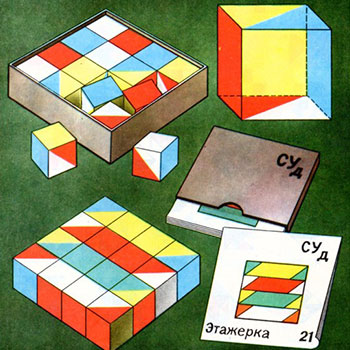In mathematical relations, then and and are represented by #-># and #∧#respectively.
So, we are to prove that either #(P->Q)∧(P->R)# #-=# #P->(Q∧R)#
or #(P->Q)∧(P->R)# #cancel(-=)# #P->(Q∧R)#
Note: I have represented equivalent sign with #-=# and not equivalent sign with #cancel(-=)#.
To find that either two statements are logically equivalent or not we use truth table. Before finding the truth tables, let me tell you the mathematical definitions of then and and relations.
then: A then statement of two statements #x# and #y#, i.e, #x->y# is false only when #x# is true but #y# is false, otherwise, it is always true. A then statement is known as implication.
and: An and statement of two statements #x# and #y#, i.e, #x∧y# is true only when #x# and #y# both are true, otherwise, it is always false. An and statement is known as conjunction.
Keep above definitions in mind.
In your given statement there are three basic statements #P#, #Q#, #R# and five compound statements #P->Q#, #P->R#, #Q∧R#, #(P->Q)∧(P->R)#, #P->(Q∧R)#. So, there are eight statements in total.
The basic three statements give rise to #2^3=8# possibilities. Now, draw a table with #9# rows and #8# columns.
In the first row, list all the statements as shown below.
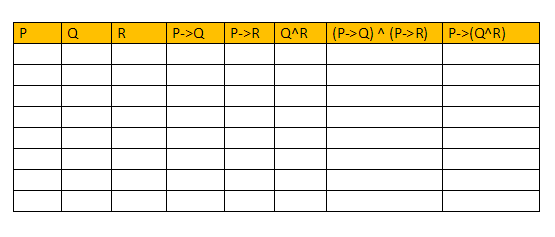
Three basic statements give rise to 8 possibilities which can be listed in the table as shown below.
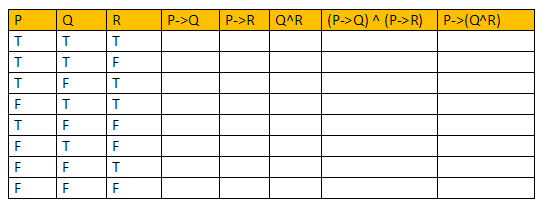
Now, fourth column represents #P->Q# statement, this will be false only when #P# is true but #Q# is false. If you look into the table you will observe that #P->Q# is false only for #3rd# and #5th# row. Similarly the statement #P->R#, in #5th# column, is false only for #2nd# and #5th# row.
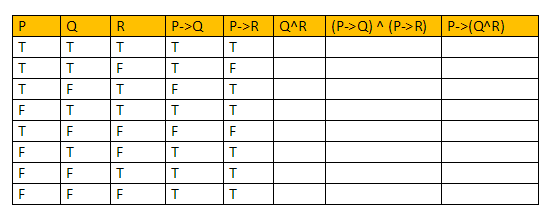
Now, sixth column represents #Q∧R# statement, this will be true only when both #Q# and #R# are true, otherwise false. In the table, #Q# and#R# both are true only in #1st# and #4th# row.
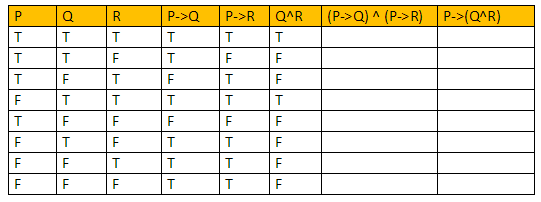
For seventh column, you need to look in #4th# and #5th#column and perform and operation on them, i.e, #7th# column is conjunction of #4th# and #5th# column. Therefore, #7th# column is true whenever both #4th# and #5th# columns are true. After looking into the table, I find that #7th# column is false for #2nd#, #3rd# and #5th# row.
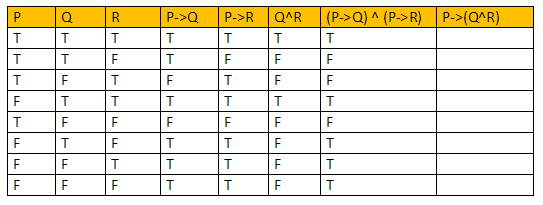
Finally for eighth column, you need to look into #1st# and #6th# column and perform then operation on them, i.e, #8th# column is implication of #1st# and #6th# column. Therefore, #8th# column is false only when #1st# column is true, but #6th# column is false. After looking into the table. I find that #8th# column is false for #2nd#, #3rd# and #5th# row.
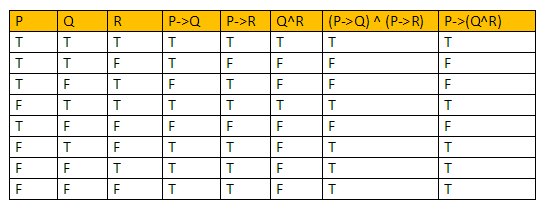
After very good hard work, the truth table is ready.
If you look into #7th# and #8th# column you will find that both the columns have same values for all the eight possibilities. That means that #7th#and #8th# columns are logically equivalent. Since, #7th# and #8th# columns represent #(P->Q)∧(P->R)# and #P->(Q∧R)# respectively, hence, they are logically equivalent.
#implies (P->Q)∧(P->R) -= P->(Q∧R)#
Hence, proved!
